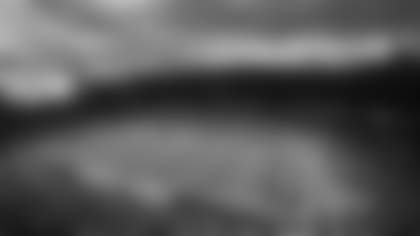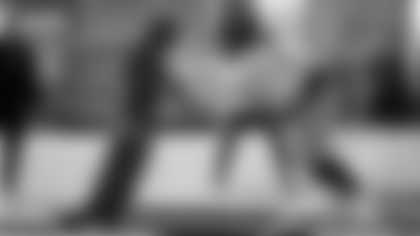In a Venn diagram where one side represents Denver Broncos players and the other represents prominent 20th century artists, there is only one person who lies in the overlapping area.
That would be Ernie Barnes, who was a guard for the team from 1963-64 and later became more well known as a painter whose works were featured on album covers for artists including Marvin Gaye and Curtis Mayfield, as well as in television shows and movies.
A little over a week ago, the internationally famous auction house Christie's in New York City held its 20th century auction, and Barnes' 1976 painting "The Sugar Shack" went for $15.3 million.
Barnes was the first (and really, to this point, is still the only) pro football player to become widely known and wildly successful in the art world.
Born in Durham, North Carolina, Barnes was interested in art from an early age.
"As a youth I would read all the books of the most famous artists of all time," I recall he once told me. "I was just captivated by the idea of being able to express oneself with a paintbrush."
Segregation and economics prevented him from seeing the works of the masters for several years, but his interest in art never waned.
An outstanding high school football player, he earned a full scholarship to North Carolina Central, an HBCU, where he majored in art. Certainly, of all the scholarship football players in our nation's history, I would imagine Ernie was one of few to major in art.
After graduation, he played pro football for several years, starting out with the Baltimore Colts in 1959 before joining the Titans of New York (who eventually became the New York Jets) in 1960. Then, Ernie played for the San Diego Chargers in 1960 and 1961, and in an offhand way that is how I first came to see his works.
At that time, the assistant ticket manager of the Chargers was Gail Stuckey, who later would be ticket manager for the Broncos.
One day in his office, I noticed several pieces by Ernie Barnes on Gail's walls, and I asked how he came to be in possession of them.
"When Ernie was still a struggling artist and playing for the Chargers, after both seasons he was looking to head home to North Carolina, but was short of funds." Gail said.
Pro football salaries then were not what they are today.
"So I paid him for a few pieces, and Ernie went home," Gail told me.
I can only hope that Gail's estate held on to those Ernie Barnes originals.
Dubbed "'Rembrandt' of the Broncos" by The Denver Post's Empire Magazine, Barnes came to Denver for the 1963 and 1964 seasons and was a solid starting guard for the Broncos. Barnes started 20 games in those two seasons and was never the reason the Broncos lacked success on the field.
Football, in fact, was a major source of inspiration for Barnes. He often worked on scenes from his profession, of the sideline, the action and even of his coaches; his painting titled "October 4, 1964" depicted Broncos head coach Jack Faulkner during his final game before the team released him from his position. Faulkner later commissioned two paintings from Barnes, as The Post's Harry Farrar reported.
"My interpretation of pro football is that the players are gladiators in the arena," Barnes told Farrar. "It's a throwback to the blood-thirsty Roman Colosseum mobs. I want my paintings to bring the crowd right into the action on the field so that the people can feel the same emotions that the players feel."
But after his time in Denver, he decided to focus on his painting entirely, encouraged by actors Vincent Price and Jack Palance, who were also art collectors or painters themselves, and their interest in his work. In this new full-time career, his success was enormous.
Ernie became recognized for being "the most expressive painter of sports since George Bellows," made his debut at the Grand Central Art Galleries in New York City and then continued to exhibit as an artist. That came in 1966, after impressing Sonny Werblin, one of the early owners of the New York Jets (the Titans when Ernie played for them).
Barnes' most famous painting is "The Sugar Shack," a piece showing a group of Black dancers. The singer Marvin Gaye later used it on the cover of his album "I Want You," which was released in 1976.
Gaye had seen several of Barnes' paintings in the back seat of Ernie's car, and it was very soon thereafter that Gaye commissioned an adaptation of the work for his album cover. The painting was inspired by the memory of an experience Barnes had as a teen, when he managed to sneak into a dance party at a venue called The Armory.
Fast forward to when I began with the Broncos in 1978. I was very familiar with his work and a few years into my tenure, I decided that it would be great if Ernie Barnes drew the cover of our media guide.
I found Ernie after a number of phone calls, and he actually returned my calls.
He could not have been more charming or gracious, but explained that his contractual situations did not allow him to paint anything without charging a fee.
Naturally, I asked what the fee might be.
Naturally, it was more than my budget for the media guide.
So we both chuckled and I congratulated him again on his fabulous career before moving on.
"The Sugar Shack," by the way, not only graced a Marvin Gaye album but was featured in the credits of a classic sitcom, "Good Times," one of the first sitcoms to focus on the struggles and successes of a Black family.
However, the enormous success of "The Sugar Shack" cannot be measured strictly by having sold for $15.3 million at Christie's.
Like all the other works of former Bronco Ernie Barnes, it helps tell positive stories about sport, art, passion and Blackness in America.
The Broncos are honored to have Ernie Barnes among our alumni.















